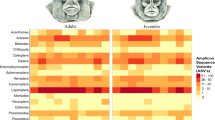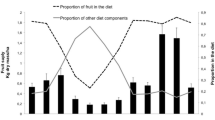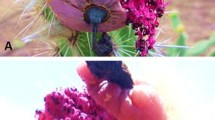Abstract
To test the hypothesis that primate populations are limited by food resources, we studied the feeding ecology of three cercopithecines and one colobine in a rain forest in central Gabon. Simultaneously, we monitored the fruiting phenology of trees and estimated the biomass of the monkey community. The Makandé Forest is dominated by Caesalpiniaceae and characterized by a lack of secondary vegetation and of trees species producing fleshy fruits. Fruit production was irregular intra- and interannually. Fruiting peaks of dry fruits (mainly Caesalpiniaceae) and of fleshy fruits occurred at the same period. However, interseasonal and interannual variability was greater in Caesalpiniaceae than in other families. As a result, the Makandé forest is subject to bottlenecks when food is scarce. On an annual basis, seeds (primarily Caesalpiniaceae) dominated the diet of all monkeys. On a seasonal basis, cercopithecines preferentially consumed fleshy fruits as long as they were available, whereas colobines increased consumption of young leaves when seed availability declined. The consumption of mature leaves was low. The monkey community biomass (ca. 204 kg/km2) is one of the lowest in Central Africa. We suggest that both cercopithecine and colobine populations are limited as a result of the combined effect of the dominance of Caesalpiniaceae, which provide dry fruits according to a mast-fruiting pattern and mature leaves of low quality, and the lack of seral successional stages, which provide fleshy fruit on a more regular pattern and leaves of better quality. During the period of food scarcity, cercopithecines should suffer from the low availability of fleshy fruit, which are their favorite food. At the same period, colobines should be limited by the low availability of edible leaves. Similar low primate biomasses are found in forests dominated by Caesalpiniaceae or Lecythidaceae in South America and in Dipterocarpaceae forests in South Asia, which suggests that their biological characteristics, in particular dry fruits and mast fruiting, are unfavorable to monkey populations. Our results confirm that habitat mosaics may support larger populations of primary consumers than homogeneous primary forests can.
Similar content being viewed by others
REFERENCES
Aubreville, A. (1968). Flore du Gabon(23 vols.), Muséum National d'Histoire Naturelle, Paris.
Boubli, J.-P. (1999). Feeding ecology of black-headed Uacaris (Cacajao melanocephalus melanocephalus) in Pico da Neblina National Park, Brazil. Int. J. Primatol. 20: 719–750.
Bourlière, F. (1985). Primate communities: Their structure and role in tropical ecosystems. Int. J. Primatol. 6: 1–26.
Brugière, D. (1998). Facteurs de variations des densités et biomasses des primates en milieu tropical forestier: L'exemple des Cercopithecidae en Afrique Centrale, Thèse de Dipl ôme Doctoral, Université de Rennes I.
Brugière, D., and Fleury, M.-C. (2000). Estimating primate densities using line transect and home range methods:Acomparative test with the black colobus monkey Colobus satanas.Primates 41: 373–382.
Cant, J. G. (1980).What limits primates? Primates 21: 538–544.
Chapman, C. A., and Chapman, L. J. (1999). Implications of small scale variation in ecological conditions for the diet and density of red colobus monkeys. Primates 40: 215–232.
Chapman, C. A., Gautier-Hion, A., Oates, J. F., and Onderdonk, D. A. (1999). African primates communities: Determinants of structure and threats to survival. In Fleagle, J. G., Janson, C., and Read, C. K. (eds.), Primate Communities, Cambridge University Press, Cambridge, pp. 1–37.
Dasilva, G. (1994). Diet of Colobus polykomos on Tiwaï Island: Selection of food in relation to its seasonal abundance and nutritional quality. Int. J. Primatol. 15: 1–26.
Davies, A. G. (1991). Seed-eatings by red leaf monkeys (Presbytis rubicunda) in Dipterocarp forest of northern Borneo. Int. J. Primatol. 12: 119–144.
Davies, A. G. (1994). Colobine populations. In Davies, A. G., and Oates, J. F. (eds.), Colobine Monkeys: Their Ecology, Behaviour and Evolution, Cambridge University Press, Cambridge, pp. 285–310.
Davies, A. G., Oates, J. F., and Dasilva, G. (1999). Patterns of frugivory in three west African colobine monkeys. Int. J. Primatol. 20: 327–357.
Doucet, J.-L. (1996). Régénération naturelle en Forêt des Abeilles. Inventaires, écologie des espèces et impact de l'exploitation, Facult é des Sciences Agronomiques de Gembloux, Gembloux.
Doucet, J. L., Moungazi, A., and Issembé, Y. (1996). Etude de la végétation dans le lot 32 (Gabon). In Biodiversité, écologie des espèces, recommandations pour une gestion soutenue, Facult é des Sciences Agronomiques de Gembloux, Gembloux.
Fimbel, C. (1994). The relative use of abandonned farm clearings and old forest habitats by primates and a forest antelope at Tiwaï, Sierra Leone, West Africa. Biol. Conserv. 70: 277–286.
Fleagle, J. G., and Reed, K. E. (1996). Comparing primates communities: A multivariate approach.J. Hum. Evol. 30: 489–510.
Fleury, M. C. (1999). Ecologie et Organisation Sociale du colobe satan Colobus satanas, Thèse de Doctorat, Université de Rennes I.
Fleury, M.-C., and Gautier-Hion, A. (1999). Semi-nomadic ranging behavior in a population of black colobus (Colobus satanas) in Gabon and its ecological correlates. Int. J. Primatol. 20: 491–509.
Ganzhorn, J.U. (1992). Leaf chemistry and the biomass of folivorous primates in tropical forests.Oecologia 91: 540–547.
Gautier-Hion, A. (1980) Seasonal variations of diets related to species and sex in a community of Cercopithecus monkeys. J. Anim. Ecol. 49: 237–269.
Gautier-Hion, A. (1997). Les forê ts d'Afrique centrale: essai comparé sur la biodiversité et les relations sol-faune-flore, Rapport pour l'Union Europeénnne (DG XII), UMR 6652, CNRS-Université de Rennes I, Rennes.
Gautier-Hion, A., Colyn, M., and Gautier, J.-P. (1999). Histoire naturelle des Primates d'Afrique Centrale, Ecofac edn., Libreville, Gabon, 162 pp.
Gautier-Hion, A., Duplantier, J. M., Emmons, L., Feer, F., Hecketsweiler, P., Moungazi, A., Quris, R., and Sourd, C. (1985). Coadaptation entre rythmes de fructification et frugivorie en for ê t tropicale humide du Gabon: Mythe ou r ´ ealit ´ e. Rev. Ecol. (Terre Vie) 40: 405–434.
Gautier-Hion, A., and Gautier, J.-P. (1976). Croissance, maturité sexuelle et sociale, reproduction chez les cercopithecinés forestiers africains. Folia. Primatol. 26: 165–184.
Gautier-Hion, A., Gautier, J.-P., and Maisels, F. (1993). Seed dispersal versus seed predation: An inter-site comparison of two related african monkeys. Vegetatio 107/108: 237–244.
Gautier-Hion, A., and Michaloud, G. (1989). Are figs always keystone ressources for tropical frugivorous vertebrates? A test in Gabon. Ecology 70: 1826–1833.
Gesnot, K. (1994). Inventaire forestier dans la Forêt des Abeilles. Mémoire de fin d'études, Université Libre de Bruxelles, Bruxelles.
Gupta, A. K., and Chivers, D. J. (1999). Biomass and use of resources in south and south-east Asian primate communities. In Fleagle, J. G., Janson, C., and Read, C. K. (eds.), Primate Communities, Cambridge University Press, Cambridge, pp. 38–54.
Harisson, M.J. S. (1986).Feeding ecology of black colobus, Colobus satanas, in central Gabon. In Lee, P. C., and Else, J. G. (eds), Primate Ecology and Conservation, Cambridge University Press, Cambridge, pp. 31–37.
Hecketsweiler, P. (1992). Phénologie et saisonnalité en forêt gabonaise: L'exemple de quelques espèces ligneuses, Thèse de Doctorat, Université de Montpellier II, Montpellier.
Janson, C. H., and Chapman, C. (1999). Resources and primate community structure. In Fleagle, J.G., Janson, C., and Read, C. K. (eds.), Primate Communities, Cambridge University Press, Cambridge, pp. 237–267.
Janzen, D. H. (1974). Tropical blackwater rivers, animals and mast fruiting by the Dipterocarpaceae.Biotropica 6: 69–103.
Janzen, D. H. (1975). Ecology of Plants in the Tropics, Edward Arnold, London.
Johns, A. D. (1988). Effects of selective timber extraction on rain forest structure and composition and some consequences for frugivores and folivores. Biotropica 20: 31–37.
Johns, A. D. (1997). Timber Production and Biodiversity Conservation in Tropical Rain Forests, Cambridge University Press, Cambridge.
Johns, A.D., and Johns, B. (1995). Tropical forest primates and logging: Long term coexistence? Oryx 29: 205–211.
Johns, A.D., and Skorupa, J. P. (1987). Responses of rain forest primates to habitat disturbance: A review. Int. J. Primatol.8: 157–191.
Kay, R. N. B., and Davies, A. G. (1994). Digestive physiology. In Davies, A. G., and Oates, J. F. (eds.), Colobine Monkeys: Their Ecology, Behaviour and Evolution, Cambridge University Press, Cambridge, pp. 229–250.
Lasserre, F., and Gautier-Hion, A. (1995). Impacts environnementaux d'une exploitation sélective en forêt tropicale: l'Okoumé en Forêt des Abeilles. Le cas de la Société Leroy-Gabon,UMR 6552, CNRS-Université de Rennes I, Rennes.
Maisels, F., and Gautier-Hion, A. (1994).Why are Caesalpinioideae so important for monkeys in hydromorphic rainforest in Zaïre basin? In Sprent, J. L., and McKey, D. (eds.), Advances in Legume Systematics. Part 5: The nitrogen factor, Royal Botanic Gardens, Kew, pp. 189–204.
Maisels, F., Gautier-Hion, A., and Gautier, J.-P. (1994). Diets of two sympatric colobines in Zaïre: More evidence on seed-eating in forests on poor soils. Int. J. Primatol. 15: 681–701.
Marsh, C.W., and Wilson, W. L. (1981). A Survey of Primates in Peninsular Malaysian Forests, Universiti Kebangsaan, Malaysia and University of Cambridge, Cambridge.
McGraw, S. (1994). Census, habitat preference and polyspecific association of six monkeys in the Lomako forest, Zaïre. Am. J. Primatol. 34: 295–307.
McKey, D. B. (1978a). Phenolic content of vegetation in two African rain forests: Ecological implications. Science 202: 61–64.
McKey, D. B. (1978b). Soils, vegetation, and seed-eating by black Colobus monkeys. In Montgomery, G.G. (ed.), The Ecology of Arboreal Folivores, Smithsonian Institution Press, Washington, pp. 423–438.
McKey, D. N., Gartlan, J. S., Waterman, P. G., and Choo, G. M. (1981). Food selection by black colobus monkeys (Colobus satanas) in relation to plant chemistry. Biol. J. Linnean Soc. 16: 115–146.
Mendes Pontes, A. R. (1999). Environmental determinants of primate abundance in Maracà Island, Romaima, Brazilian Amazonia. J. Zool. Lond. 247: 189–199.
Milton, K. (1982). Dietary quality and populations regulation in a howler monkey population.In Leigh, E. G., Rand, A. S., and Windsor, D. M. (eds.), The Ecology of a Tropical Forest: Seasonnal Rhythms and Long-Term Changes, Smithsonian Institution Press, Washington, pp. 273–290.
Oates, J. F. (1994). The natural history of African colobines. In Davies, A. G., and Oates, J. F. (eds.), Colobine Monkeys: Their Ecology, Behaviour and Evolution, Cambridge University Press, Cambridge, pp. 75–128.
Oates, J. F., Whitesides, G. H., Davies, A. G., Waterman, P. G., Green, S. M., D asilva, G. L., and Mole, S. (1990). Determinants of variation in tropical forest primate biomass: New evidence from West Africa. Ecology 71: 328–343.
Opler, P. A., Baker, H. G., and Frankie, G.W. (1980). Plant reproductive characteristics during secondary succession in Neotropical lowland forest ecosystems. Biotropica 12 (Suppl. 1): 24–39.
Peres, C. A. (1994). Primate responses to phenological change in an Amazonian terra firme forest. Biotrop. 26: 98–112.
Peres, C. A. (1997a). Primate community structure at twenty western Amazonian flooded and unflooded forests. J. Trop. Ecol. 13: 381–405.
Peres, C.A. (1997b). Effects of habitat quality and hunting pressure on arboreal folivore densities in neotropical forests:Acase study of howler monkeys (Alouatta spp.). Folia Primatol. 68: 199–222.
Peres, C.A. (1999). Effects of subsitence hunting and forest types on the structure of Amazonian primate communities. In Fleagle, J. G., Janson, C., and Read, C. K. (eds.), Primate Communities, Cambridge University Press, Cambridge, pp. 268–283.
Plumptre, A. J. (1998). The effect of food supply and predation on primate densities in Budongo Forest. In International Primatological Society (ed.), Abstract of the XVII Congress of IPS, Tannanarive, Madagascar, IPS, no. 228.
Plumptre, A. J. (2000). Monitoringmammalpopulations with line transect techniwues in African forests. J. Appl. Ecol. 37: 356–368.
Plumptre, A. J., and Reynolds, V. (1994). The effect of selective logging on the primate populations in the Budongo Forest Reserve, Uganda. J. Appl. Ecol. 31: 631–641.
Richard, A., and Léonard, G. (1993). Le Gabon, Edicef/Edig, Vanves.
Struhsaker, T. T. (1975). The Red Colobus Monkey, The University of Chicago Press, Chicago.
Struhsaker, T. T. (1981). Census methods for estimating densities. In Subcommitee on Conservation of Natural Populations (ed.), Techniques for the Study of Primate Population, National Academy Press, Whashington, DC, pp. 36–80.
Struhsaker, T. T. (1997). Ecology of an African Rain Forest. Logging in Kibale and the Conflict Between Conservation and Exploitation, University Press of Florida, Gainesville.
Terborgh, J. (1983). Five New World Primates: A Study in Comparative Ecology, Princeton University Press, Princeton.
Terborgh, J., and van Schaik, C. (1987). Convergence vs. nonconvergence in primate communities.In Gee, J.H. R., and Giller, P. S. (eds.), Organisation of Communities: Past and Present, Blacwell Scientific, Oxford.
Thomas, S. C. (1991). Population densities and patterns of habitat use among anthropoïd primates of the Ituri forest, Zaïre. Biotropica 23: 68–83.
Tutin, C. E. G., and Fernandez, M. (1993). Relationships between minimum temperature and fruit production in some tropical forest trees species in Gabon. J. Trop. Ecol. 9: 241–248.
Tutin, C. E.G., Ham, R., White, L. J. T., and Harrison, M. J. S. (1997). The primate community of the LopéRéserve: Diets, responses to fruit scarcity and effects on biomass. Am. J. Primatol. 42: 1–24.
van Schaik, C., Terborgh, J., and Wright, S. J. (1994). The phenology of tropical forests: Adaptative significance and consequences for primary consumers. Annu. Rev. Ecol. Syst. 24: 353–377.
Waterman, P.G., Ross, J., Bennett, E. L., and Davies, A.G. (1988).Acomparison of the floristics and leaf chemistry of the tree flora in two Malaysian rain forests and the influence of leaf chemistry on poppulation of colobine monkeys in the OldWorld. Biol. J. Linnean Soc. 34: 1–32.
White, L. J. T. (1992). Vegetation history and logging disturbance: Effects on rain forest mammals in the Lopé Réserve, Gabon, PhD Thesis, University of Edinburgh, Edinburgh.
White, L. J. T. (1994a). Biomass of rain forest mammals in the Lope Reserve, Gabon. J. Anim.Ecol. 63: 499–512.
White, L. J. T. (1994b). Patterns of fruit-fall phenology in the Lopé Reserve, Gabon. J. Trop.Ecol. 10: 289–308.
White, L. J. T., and Abernethy, K. (1996). Guide de la végétation de la Lopé, Ecofac, Libreville.
Whitesides, G. H., Oates, J. F., Green, S. M., and Kluberdanz, R. P. (1988). Estimating primate densities from transects in aWest African rain forest:Acomparison of techniques. J. Anim.Ecol. 57: 345–367.
Wilks, C. (1989). Prospection Lots Leroy-Gabon no. 28 et no. 30, Africa Forest, Libreville.
Author information
Authors and Affiliations
Rights and permissions
About this article
Cite this article
Brugiere, D., Gautier, JP., Moungazi, A. et al. Primate Diet and Biomass in Relation to Vegetation Composition and Fruiting Phenology in a Rain Forest in Gabon. International Journal of Primatology 23, 999–1024 (2002). https://doi.org/10.1023/A:1019693814988
Issue Date:
DOI: https://doi.org/10.1023/A:1019693814988




